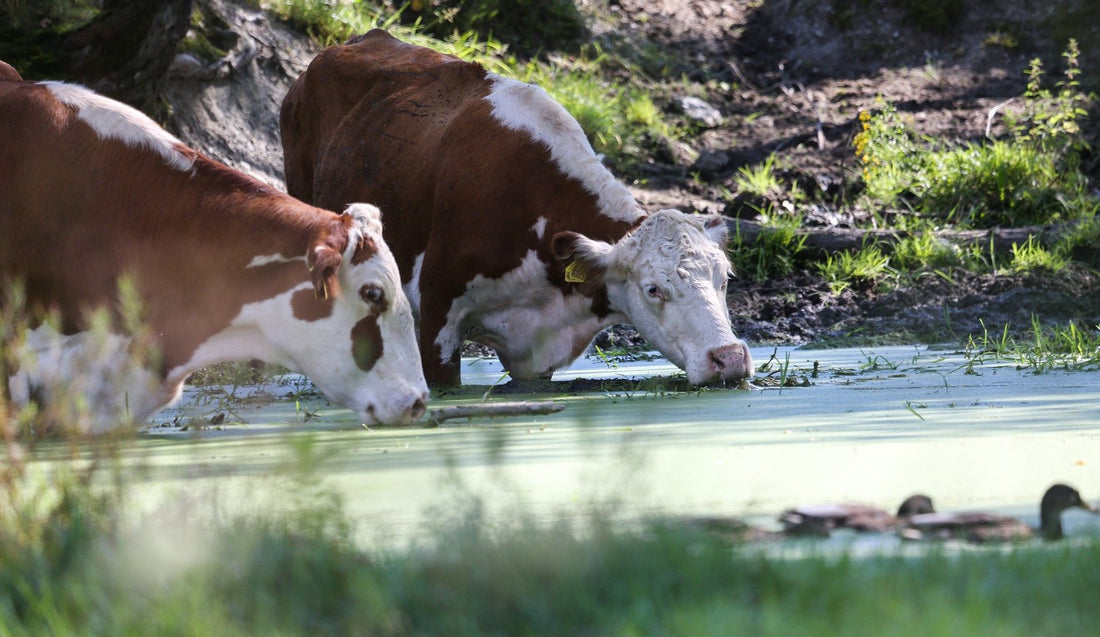The Myth of Too Much Water
Force of Nature

Why It’s Silly to Criticize Meat for Using Too Much Water
Meat has been unfairly tagged as the source of numerous contributions to climate change and environmental destruction. While some of these attributions are legitimate—when it comes to factory farming, that is, certainly not when it comes to regenerative agriculture—others are not, especially when contextualized properly. For example, one of the biggest myths surrounding the production of meat for human consumption is that raising cattle uses too much water.
While it’s true that cattle do consume water (approximately 27 gallons of water per day for a non-lactating beef cow), so does every other living creature, including, of course, humans.
How Much Water Do Humans Use?
This eco-friendly shower head uses 1.75 gallons of water per minute. Assuming that the average person showers for 12 minutes a day, that equates to 21 gallons of water used for a single shower. And, of course, most people shower at least once a day, so during just a single shower, human use of water begins to approach that of a beef cow. And that’s not even taking into account the fact that many people aren’t using “eco-friendly” shower heads; some shower heads use 7 to 10 gallons of water per minute, equating to as much as 120 gallons of water in a single shower.

It’s tempting to end this article right there. Point made, right? But, for fun, let’s continue. How about laundry? According to Energy Star, older washing machines use 40 gallons of water per load. Newer top-loading models use 27 gallons of water, and efficient Energy Star washers use 14 gallons per load. The average American household does 300 loads of laundry per year, meaning that, on average, an American household uses anywhere between 4,200 and 12,000 gallons of water per year just to do their laundry.
Finally, and perhaps most tellingly, because it’s the only use of water on this list that is absolutely, non-negotiably essential for human survival, how about drinking? It’s recommended that a person should drink at least eight eight-ounce glasses of water per day. That’s 64 ounces of water per person, per day, (more for athletes and very active individuals). Over a lifetime, a human will drink an average of 1,868,800 ounces of water. That’s 14,027.16 gallons.
Contrast these numbers with beef cattle, who consume only 1800 gallons of water on average over their lifetime by some estimates.
A More Sensible Solution
The point of presenting the above data is not, of course, to criticize humans and their water usage, but rather to illustrate the futility of arguing against water used in the raising of cattle when, indeed, eating meat is a necessary part of being human. We’re not saying that some individual humans can’t survive without eating meat, but the science is clear that, as a species, meat is an essential part of the human and pre-human diet and has been for 2.6 million years. Just as we need to drink water to survive, we need to eat meat to thrive—and enough individuals must thrive in order for a species to survive. Judging either one would be a foolish endeavor.
None of this is to say, though, that our current agricultural system is the best way of doing things—or that it makes the most efficient use of the water necessary to sustain life. Indeed, growing crops to feed cattle is part of a broken system. The amount of water used to raise cattle does indeed increase when we factor in the water used to grow the crops that feed the cattle. Eliminating the cattle wouldn’t solve this problem, though. Doing so would only mean we’d need to grow more crops to feed humans what would then be a nutrient-deficient diet.
So what’s the solution?
We’ve clearly illustrated that it’s impossible to stop humans from consuming water. Nor would we want to. After all, the water cycle is just one system in a larger system of intricate systems that make up the way our planet sustains itself and the lifeforms on it. These systems have worked well for millions of years, and it’s only in the last ten thousand or so, with the advent of agriculture, that we’ve begun to tamper with them. That’s a minuscule fraction of our planet’s timeline. But it’s not too late to revert to a more synergistic way of feeding humanity, one that aligns our biological needs with those of the planet.

Of the water used to raise a grass-fed cow, 97% is what is called green water—that is, water that is already stored in the soil from rainfall. Only 3% of a grass-fed cow’s water consumption is blue, or fresh, water—less per pound than that used to grow avocados, walnuts, or sugar. Even grain-fed beef uses 94% green water. A regeneratively raised cow uses the same amount of water as a grass-fed cow (it is, after all, grass-fed and -finished), while also contributing back to the environment in a way that keeps all ecosystems and environmental cycles in check.
This is all more than can be said for humans. When we wash our clothes, we create gray, or polluted water. We don’t even re-commit our bodies to the soil when we die, instead pumping them full of preservative chemicals and placing them in boxes.
So instead of asking yourself whether eliminating beef from your diet will cut the amount of water you consume (it won’t, not in a way that will have any sort of impact), a sacrifice that wouldn’t be worth it from a nutrition standpoint, ask yourself what else you can do to conserve water, like take shorter showers, do fewer loads of laundry, and consume better beef, instead.